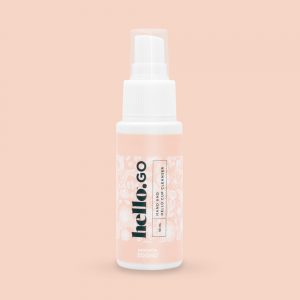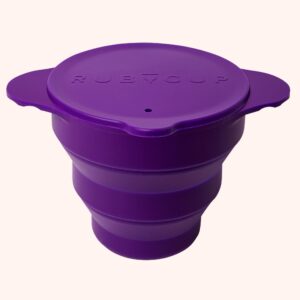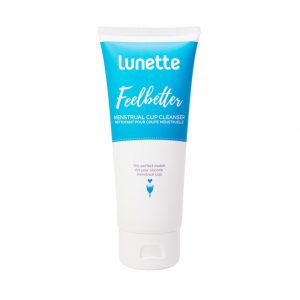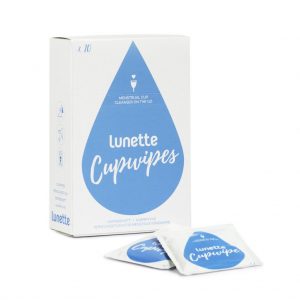How to Clean a Menstrual Cup at Home, Work or on the Go
With the right techniques and products, cleaning a menstrual cup is super easy!

Since menstrual cups are reusable, it’s important to make sure you clean and sanitise them before, during and after your period cycle. Our cleaning recommendations are suitable for most menstrual cup brands — including Juju Cups and Diva Cups. But keep in mind that each brand has its own specific cleaning products and instructions. Learn exactly how to clean a menstrual cup with our simple guidelines.
Cleaning your menstrual cup during your cycle
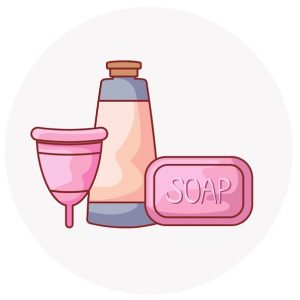 It’s important to wash your menstrual cup with clean water at least twice a day during your cycle (every 12 hours), and ideally every 4-8 hours. After removing your cup and emptying the contents, simply wash the cup under cold water and then re-insert. You may also use a scent-free, water-based (oil-free) soap or one of the specially designed wipe or wash options.
It’s important to wash your menstrual cup with clean water at least twice a day during your cycle (every 12 hours), and ideally every 4-8 hours. After removing your cup and emptying the contents, simply wash the cup under cold water and then re-insert. You may also use a scent-free, water-based (oil-free) soap or one of the specially designed wipe or wash options.
Menstrual cup washes are specifically formulated to safely clean your cup, minimising any risk of deterioration. You can use any menstrual cup wash with any cup brand.
Even soaps that contain natural oils can actually de-nature the medical silicone and soften it slightly. This can lead to faster perishing or deterioration of your cup. If you can’t seem to find a suitable soap for cleaning your menstrual cup, check out our article on scent-free oils and soaps.
Helpful Tip: You will find that rinsing your cup first in cold water, followed by warm water, will help prevent discolouration. Cold water prevents stains from setting into the silicone.
If you are cleaning your cup in a public restroom, simply empty the contents into the toilet and use a menstrual cup wipe, wet paper towel or toilet paper. Afterwards, re-insert as normal.
Be sure you clean all air holes and the rim of the cup thoroughly. You can usually stretch the silicone carefully to wash these areas under running water. If needed, use a soft toothbrush (dedicated specifically to the cup), or a toothpick (dispose of after use) to help remove stubborn debris.
Menstrual cup cleaning at the end of your cycle
It is usually recommended that you sterilise your menstrual cup before and after each cycle. You can use the following methods to sterilise and store your menstrual cup once your period is over.
How to clean your menstrual cup with boiling water
- Bring a pot of water to a boil.
- Place your cup in the water.
- Make sure the cup does not sink to the bottom of the pot (it could melt when coming into contact with the saucepan base).
- Boil for 2-10 minutes (depending on the specific brand)
- Remove the cup and allow it to air dry.
Helpful Tip: To prevent the cup from touching the base of the pot, you can try positioning it in a whisk that is placed inside the pot. You should also dry the cup in the sun to prevent the chances of discolouration.
If your cup gets burned or damaged on the base of the saucepan during boiling, you may need to replace it.
How to sterilise your menstrual cup without boiling
Alternatively, silicone menstrual cup sterilisers and microwave sterilisation bags can be used to boil/steam your cup at the end of your cycle. Both products will typically clean your cup in under 5 minutes. Take special care when using these products and keep them out of reach of children, especially when the water is boiling hot.
*Please note that certain menstrual cup brands cannot be cleaned using microwave sterilisation products as it may cause damage. Refer to the cleaning instructions for the cup brand you own.
You can also sterilise your menstrual cup by dissolving a Milton sterilising tablet in a bowl of water and then sitting your cup in this solution for the recommended time. Once dry, store your cup in the accompanying carry pouch or a cotton bag. It is not recommended to store a menstrual cup in an airtight container or plastic bag as it should have airflow to help reduce any potential accumulation of bacteria.
How to wash your menstrual cup carry pouches
We recommend cleaning your menstrual cup carry pouch at the end of each cycle. That way, you can store the newly sterilised cup in a clean pouch – ready for next time. The carry pouches for each of the cups can usually be machine washed as often as you want to. Simply throw the pouches into the washing machine with the rest of your laundry.
How to clean a menstrual cup to prevent odour
Silicone doesn’t have an odour in itself; however, your cup may begin to develop a smell in some cases. This may be caused by certain cleansers or by factors unique to each woman. You can try boiling your cup as explained above. If the odour is still present, purchase a new one or refer to our tips on removing menstrual cup odour.
What not to use when sterilising a menstrual cup
Depending on the menstrual cup brand, it is generally not recommended to clean the cup using the following products:
- Scented/fragranced or anti-bacterial soaps
- Vinegar
- Tea-tree oil
- Oil-based soaps
- Rubbing alcohol
- Hand sanitiser
- Pre-moistened wipes
- Hydrogen peroxide
- Bleach
- Other harsh chemicals
Avoiding these types of cleaning agents is important as they are not designed to be used internally and may also compromise or denature the condition of the cup.
It is also not advised to wash your menstrual cup in the dishwasher. Although it would come out of the wash cycle clean, it would still have the chemicals from the dishwashing detergent on its surface. These are not chemicals designed to be placed internally.
Clean and sterilise your menstrual cup today:
Strive to clean your menstrual cup daily while on your period and follow it up with monthly sterilisation. Although your vagina is self-cleaning, it is still sensitive to foreign and harsh substances. That means you need to clean the cup thoroughly using gentle soaps and cleaners. And once you figure out how to sterilise your menstrual cup and keep it clean, stick to the routine! Your body and the planet will both thank you later.
Frequently asked questions:
Learn more about how to wash a menstrual cup in the FAQs below.
You typically need to clean your menstrual cup every 12 hours. However, it’s advisable to clean it more often. Try to clean your cup every 4 – 8 hours while on your period, especially if you have a heavy flow. Once your period is over, sterilise the cup to prepare it to be used again the following month.
You cannot clean a menstrual cup with rubbing alcohol. The substance has the potential to ruin the integrity of the silicone. In addition, if any of the rubbing alcohol remains on the cup, it could harm the vagina upon insertion. You may need to replace your cup if you have used harsh cleaning products on it before.
It is not advisable to clean your cup with hydrogen peroxide unless you use a 3% solution. The cup can remain submerged in the solution overnight (7-8 hours). However, make sure you do not leave the cup in the solution for longer than 12 hours.
Learn more about menstrual cup care:
How to dispose of your old menstrual cup
Unfortunately there will come a point in time when your menstrual cup may have served you well, but is now in need of replacing. One of the primary reasons women are turning to menstrual cups is because of the significant amount of environmental waste saved by switching from disposable pads and tampons. So, is your
When you can’t find oil & scent free soap
How to clean your menstrual cup when you can’t find an oil and scent free soap When it comes to cleaning your menstrual cup, most brands will recommend that you only us a soap that is both oil and scent/fragrance free. Sometimes this is easier said than done. There are two reasons most of the
5 tips for removing menstrual cup stains
5 Tips for Removing Menstrual Cup Stains It is the nature of silicone to eventually stain over time. This is nearly inevitable with most clear menstrual cups, however, there are a few things you can do to delay any staining and to remove stains that may have formed. What is important to remember is that,

